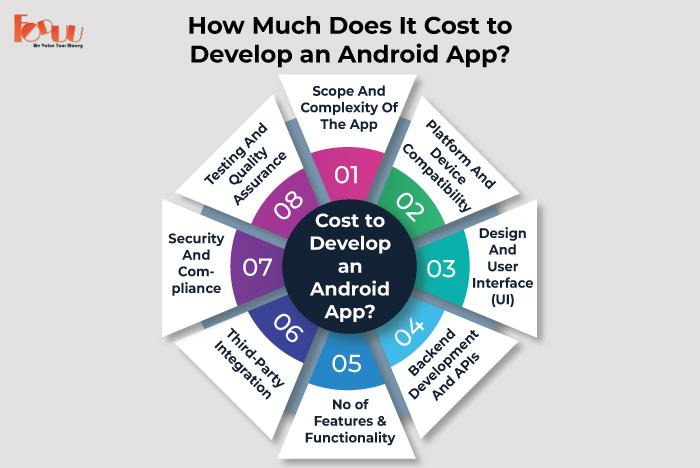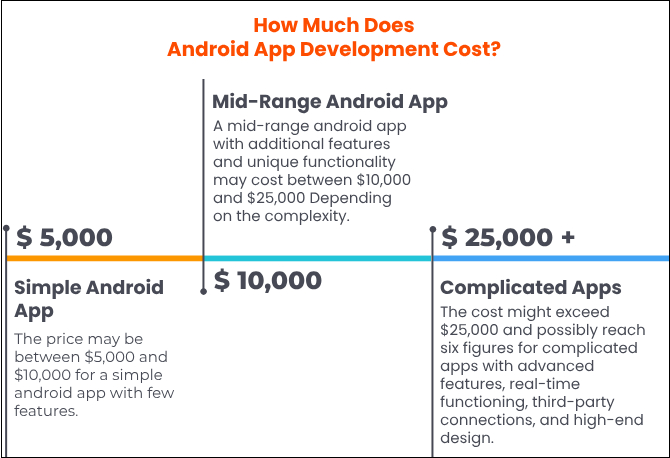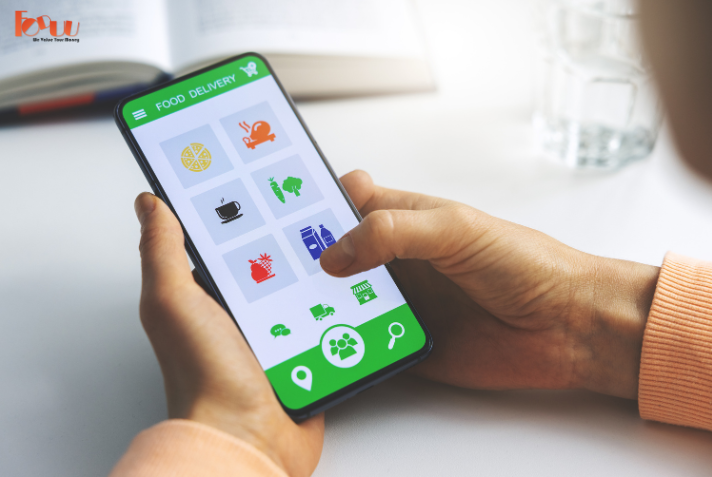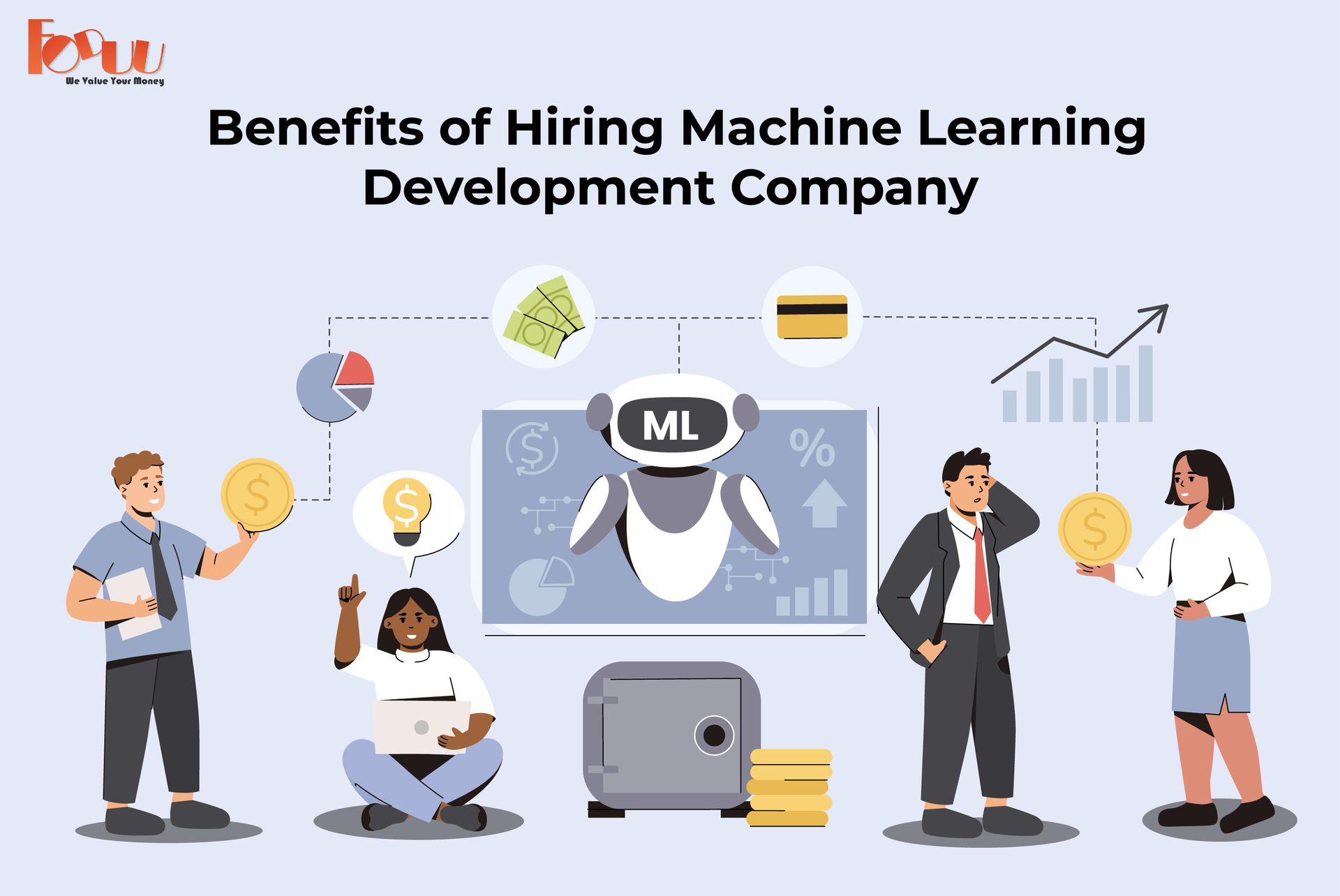What Is Android App Development?
Mobile applications have developed into vital tools for businesses and entrepreneurs trying to reach a larger audience in the current digital era. Android stands out among the most popular platforms for its enormous user base.
Making wise choices, however, requires having a clear awareness of the costs related to Android app development. In-depth discussion of the variables affecting an Android app's development cost will be provided in this thorough tutorial.
Importance Of Android app Development in Businesses in Today’s World
Android app development is important for several reasons, spanning both the business and consumer perspectives. Here are some key reasons holds significant importance:
1. Market Dominance:
It is the most widely used mobile operating system globally, powering a vast majority of smartphones and tablets. Developing apps for Android allows businesses to tap into a massive user base, reaching millions of potential customers worldwide.
2. Global Reach:
Popularity extends across regions and demographics, offering developers the opportunity to target diverse markets and audiences. Whether it's emerging economies or developed nations, Android apps can penetrate various segments of the population, driving user engagement and revenue generation.
3. Revenue Generation:
Apps provide avenues for businesses to monetize their offerings through various means such as in-app purchases, subscriptions, advertising, and premium app sales. With effective monetization strategies, developers can generate substantial revenue streams, contributing to business growth and sustainability.
4. Brand Visibility and Recognition:
Having a presence on the Google Play Store through Android apps enhances brand visibility and recognition. Apps serve as powerful marketing tools, allowing businesses to showcase their products, services, and brand identity to a global audience. A well-designed and user-friendly app can leave a lasting impression, fostering brand loyalty and customer engagement.
5. Enhanced Customer Engagement:
Apps enable businesses to establish direct communication channels with their customers. Through features like push notifications, personalized offers, and real-time updates, businesses can engage users proactively, drive customer loyalty, and gather valuable feedback for continuous improvement.
6. Competitive Advantage:
In today's digital landscape, having a mobile app has become a standard practice for businesses across industries. By investing in Android app development, companies gain a competitive edge over rivals, staying ahead of the curve and meeting evolving consumer expectations.
7. Innovation and Differentiation:
Android app development fosters innovation by enabling businesses to explore new ideas, experiment with features, and deliver unique solutions to market challenges. Whether it's integrating cutting-edge technologies like augmented reality (AR), artificial intelligence (AI), or Internet of Things (IoT), Android apps serve as platforms for innovation and differentiation.
8. Data Insights and Analytics:
Android apps provide valuable data insights and analytics, allowing businesses to track user behavior, preferences, and interactions. By leveraging data-driven decision-making, businesses can refine their strategies, optimize app performance, and tailor user experiences to drive engagement and conversion.
9. Customer Convenience and Accessibility:
Mobile apps offer unparalleled convenience and accessibility to users, enabling them to access services, make purchases, and interact with brands anytime, anywhere. Android apps cater to users' on-the-go lifestyles, providing seamless and intuitive experiences that enhance user satisfaction and loyalty.
Factors that Affect Cost of Android App Development in India

1. Scope And Complexity Of The App
Depending on its intended use and features, an Android app's scope and complexity might vary greatly. Simple applications may perform a single task, such as a torch or calculator, and only need rudimentary user interfaces and backend processing.
Contrarily, sophisticated programmes, like social networking platforms or e-commerce applications, require a big backend infrastructure and have many different capabilities.
The scope include identifying the app's goals, target market, and important features. This involves designing user interfaces, managing data, and integrating other services. For instance, user verification, profile building, messaging, and content sharing would all be required for a social networking app.
Data management, real-time communications, and third-party connections are examples of elements that affect complexity. Apps with complicated algorithms, machine learning aspects, or augmented reality features are regarded as being very complex.
Complexity is also increased by support for many screen sizes and cross-platform compatibility (Android phones, tablets, and wearables).Complexity is further increased by scalability and security issues. Strong backend systems and databases are required for apps with a big user base to handle the volume of concurrent queries.
Complexity is increased by using encryption, security protocols, and safeguards against cyberthreats to secure user data.In general, the breadth and complexity of an Android app depend on the envisioned features, the degree of user engagement, and the technological prerequisites to achieve the goal for which it is designed.
2. Platform And Device Compatibility
To guarantee that an Android app reaches the largest audience possible, platform and device compatibility is a critical component of development. Since Android is an open-source operating system, it is supported by a wide range of devices made by several manufacturers, creating a diversified ecosystem.
The Android operating system versions that the app is compatible with are referred to as platform compatibility. To do this, choose which Android API levels the app will support. A wider user base is ensured by compatibility with earlier versions, but it may restrict access to newer features. Targeting the most recent versions, on the other hand, enables the exploitation of cutting-edge functionality but can shut off people using older devices.Screen sizes, resolutions, and hardware capabilities are just a few examples of variables that affect how devices work together.
The software adapts to many screen sizes, including phones, tablets, and even wearables, thanks to the use of flexible UI components and adaptable layout design. Additionally, for programmes that depend on such functions, taking into account hardware components like camera, GPS, accelerometer, and NFC (Near Field Communication) is essential.In addition, different device manufacturers with their unique customised Android releases must be taken into consideration.
To find and fix any compatibility problems, testing must be done on a variety of devices made by different manufacturers.Achieving thorough platform and device compatibility guarantees that an Android app can be used with ease across a variety of devices and Android versions, providing the best user experience to a varied user base.
3. Design And User Interface(UI)
A key component of producing a satisfying user experience is designing the user interface (UI) for an Android app. Users may interact with it through its interactive and visual components. A well-designed user interface (UI) not only makes the programme visually appealing but also improves its usability and intuitiveness.
First, think about who the app is intended for and who it is for. This makes it easier to select a design aesthetic that appeals to users. A game software may choose a more colourful and exciting design, while a finance app would adopt a more tidy, professional appearance.
A crucial element is navigation. Users can quickly navigate the app thanks to its intuitive menus, buttons, and gestures. Users are quickly guided to their intended destinations with a well-organised menu layout and informative labelling.
Design aspects must be consistent. This entails utilising consistent iconography, typography, and colour palettes across the whole programme. Consistency encourages familiarity, which makes it simpler for users to browse and comprehend the functionality of the programme.
Determine the hierarchy of the material. Secondary components can be more softly merged while important information should be highlighted loudly. By doing this, consumers are guaranteed speedy access to the most pertinent data.
Accessibility is also another crucial factor. Design components should be accessible, offering alternatives for people with various abilities, and according to accessibility guidelines.Last but not least, user testing and feedback are crucial. Real users are used to conduct usability testing, which aid in locating any problems or UI design flaws.
4. Backend Development And APIs
An Android app's connectivity and functioning are crucially dependent on backend development and APIs. The application architecture, databases, and server-side logic that power the functionalities of the app are referred to as the backend.
Backend development must include database design. It entails organising data in a form that facilitates effective retrieval, storage, and manipulation. SQL databases, like MySQL, are frequently used for structured data, whereas NoSQL databases, like MongoDB, are used for more adaptable data formats.
Application Programming Interfaces, or APIs, act as links between the frontend (the user interface of the programme) and the backend. They allow various software components to communicate with one another and share data. RESTful APIs, which enable stateless, client-server interactions using conventional HTTP techniques, are frequently utilised in the creation of Android apps.
To enable secure access to app functionalities, user authentication and permission processes are established on the backend. For secure user login and data security, this comprises strategies like token-based authentication or OAuth.Scalability is a key factor to take into account, especially for programmes that anticipate having a huge user base.
Using techniques like load balancing, caching, and cloud services like AWS or Google Cloud, backend developers can handle additional traffic.Additionally crucial elements are error management and data validation. In order to protect against problems like data corruption or unauthorised access, backend systems should be able to manage possible mistakes and assure data integrity.
An Android app's basis is mostly comprised of backend development and APIs, which allow it to carry out necessary tasks, connect to external services, securely handle data, and ultimately provide a flawless user experience.
5. No of Features & Functionality
An Android app's purpose and the value it provides to users are defined by its features and functionality. The purpose of these components is to deliver a seamless user experience while also catering to special demands.This covers the app's main objective. For instance, giving accurate weather information would be the main feature of a weather app.
For personalised experiences, several apps need the creation of user accounts. Users can use this feature to register, log in, and manage their profiles.A user-friendly design and intuitive navigation are essential. This contains easy-to-use interface tools like buttons, menus, and gestures.Users may either produce material (like social media postings) or receive content (like reading articles in a news app), depending on the app.
Search and filter functionalities are useful in apps with a lot of data since they help users locate what they're looking for fast.Users are engaged and informed about significant app upgrades or events thanks to push notifications.
Even when offline, some apps offer a restricted set of features. Users may be able to make, modify, and store notes offline, for example, using the notes app. Apps can provide location-specific capabilities, such as locating nearby locations or offering instructions, using GPS.This enables users to link their social media accounts with their app accounts for sharing and socialising.Secure payment processing and tracking of transaction histories are essential features in e-commerce and banking apps.
This covers functions including editing, playing, and uploading of images and videos.It improves user happiness and app development to provide a conduit for consumers to offer comments or request support.
Also Read: 9 Things To Consider Before Developing A Mobile App
6. Third-Party Integration
Android apps can access more resources or improve functionality by integrating third-party services, libraries, or APIs. This method is essential for increasing capabilities and enhancing user experiences.For functions like social login, content sharing, or user profiles access, apps frequently interface with websites like Facebook, Twitter, or Instagram.
Apps can offer location-based features like as directions, geotagging, and suggestions for nearby places by using APIs from Google Maps or other mapping services. For safe and simple in-app transactions, e-commerce or financial apps should integrate with payment processors like PayPal, Stripe, or Square.Users may save files, read them, and share them right from the app with services like Google Drive, Dropbox, or OneDrive.
Apps may notify users in real-time, keeping them interested and informed, by integrating services like Firebase Cloud Messaging or OneSignal. A safe and simplified user login and registration procedure is made possible by using services like Firebase Authentication or OAuth.Through features like SMS messaging or email alerts, integration with providers like Twilio or SendGrid enables in-app communication.Instant messaging capabilities are offered by services like SendBird and Chatkit, enabling real-time communication within the app.
Integrating with services like PayPal, Stripe, or Braintree makes in-app purchases and transactions safe and simple. In-app advertising may be used to monetise a platform by integrating ad services like Google AdMob or Facebook Audience Network.
Apps that integrate with APIs from services like TensorFlow or IBM Watson may take use of cutting-edge features like picture recognition and natural language processing.
7. Security And Compliance
When developing Android apps, security and compliance are of utmost importance. Safeguarding user data, preventing unauthorised access, and defending against online threats are all aspects of security. To reduce vulnerabilities, this includes strategies like encryption, safe authentication, and secure coding practises.
In order to ensure that the app complies with regulatory requirements, compliance means upholding industry and legal norms. This includes regulations governing data protection, such as GDPR, HIPAA for applications relating to healthcare, or PCI DSS for those involving payments.
Following compliance guidelines helps establish confidence with consumers while avoiding legal ramifications. To find and fix any vulnerabilities, it's essential to conduct regular security audits, penetration tests, and code reviews. Utilising safe libraries and frameworks is crucial, as is remaining up to speed with security fixes.T
he app is safeguarded from any breaches or legal repercussions by implementing a strong security posture and ensuring compliance. As security risks and regulatory environments change, this process requires constant awareness and flexibility.
8. Testing And Quality Assurance
For an Android app to run dependably, to live up to user expectations, and to maintain a high level of performance, testing and quality assurance are essential stages in the development process.
To do this, the code's constituent parts or components must be tested to ensure their accuracy. It assists in finding and fixing issues early in the development process.This evaluates how various modules or components interact with one another to make sure they function properly together.
This verifies the app functions as planned by comparing them to the criteria listed.In order to do this, the user interface of the app must be tested to see if it is user-friendly, responsive, and aesthetically pleasing across a variety of screens and devices.
It makes that the app runs properly on different Android devices, operating system versions, and screen resolutions. This evaluates the resource utilisation, performance, and responsiveness of the app in various scenarios.
Data encryption, secure authentication, and defence against typical security threats are just a few examples of the security risks and weaknesses that must be found within the programme. This evaluates how effectively the software satisfies user expectations, as well as how user-friendly it is overall and easy to navigate.
It makes sure that recent modifications or upgrades haven't damaged any current features or added any new issues. In order to make sure the app is reliable and runs properly under large user traffic, these tests assess how the app responds to stress and high loads.
Makes ensuring that the software is usable across a variety of linguistic and cultural contexts.Using accessibility principles and standards, this determines if the software is usable by people with impairments.To guarantee the app is solid, dependable, and offers a smooth user experience, quality assurance is a thorough testing procedure that identifies problems and works to fix them.
How Much Does Android App Development Cost in India?
Depending on variables including complexity, features, and the level of developer experience, the cost of developing an Android app in India might vary greatly.
- The price may be between $5,000 and $10,000 for a simple android app with few features.
- A mid-range android app with additional features and unique functionality may cost between $10,000 and $25,000. Depending on the complexity,
- The cost might exceed $25,000 and possibly reach six figures for complicated apps with advanced features, real-time functioning, third-party connections, and high-end design.

It's vital to keep in mind that these are approximations and may change depending on the specific project needs, technological stack, and price policies of the development business. India is a desirable location for firms wishing to produce high-quality Android applications at affordable prices since it is well-known for its cost-effectiveness in software development. But it's important to put quality first and select respected, experienced development companies while still taking expenses into account.
Conclusion
For companies wishing to increase their digital presence and reach a larger audience, developing an Android app is a wise investment. For making wise choices and guaranteeing a good conclusion, it is crucial to understand the elements that affect the cost of developing Android apps.
Businesses may successfully manage the app creation process by taking into account factors such as scope, complexity, design, features, and hiring the best app development firm. Businesses may develop an Android app of the highest calibre that supports their objectives and enhances their web presence with careful preparation and a clear vision.
FODUU: Your Trusted Partner for Android App Development in India
FODUU is an android app development company in India Crafting Innovative Android Apps for Businesses Worldwide. Transform Your Ideas into Reality with FODUU's Affordable Android App Development Services.
We provide competitive prices without sacrificing quality because of a dedication to cost effectiveness. Excellence in design, functionality, and user experience are our top priorities from conception through implementation.
You can depend on us to turn your concepts into user-friendly, feature-rich Android applications that appeal to your target market. With the help of our first-rate development services, improve your mobile presence. We put an emphasis on your achievement.
Contact us or call us at +91 881 730 4988 for android app development services at affordable prices today!





